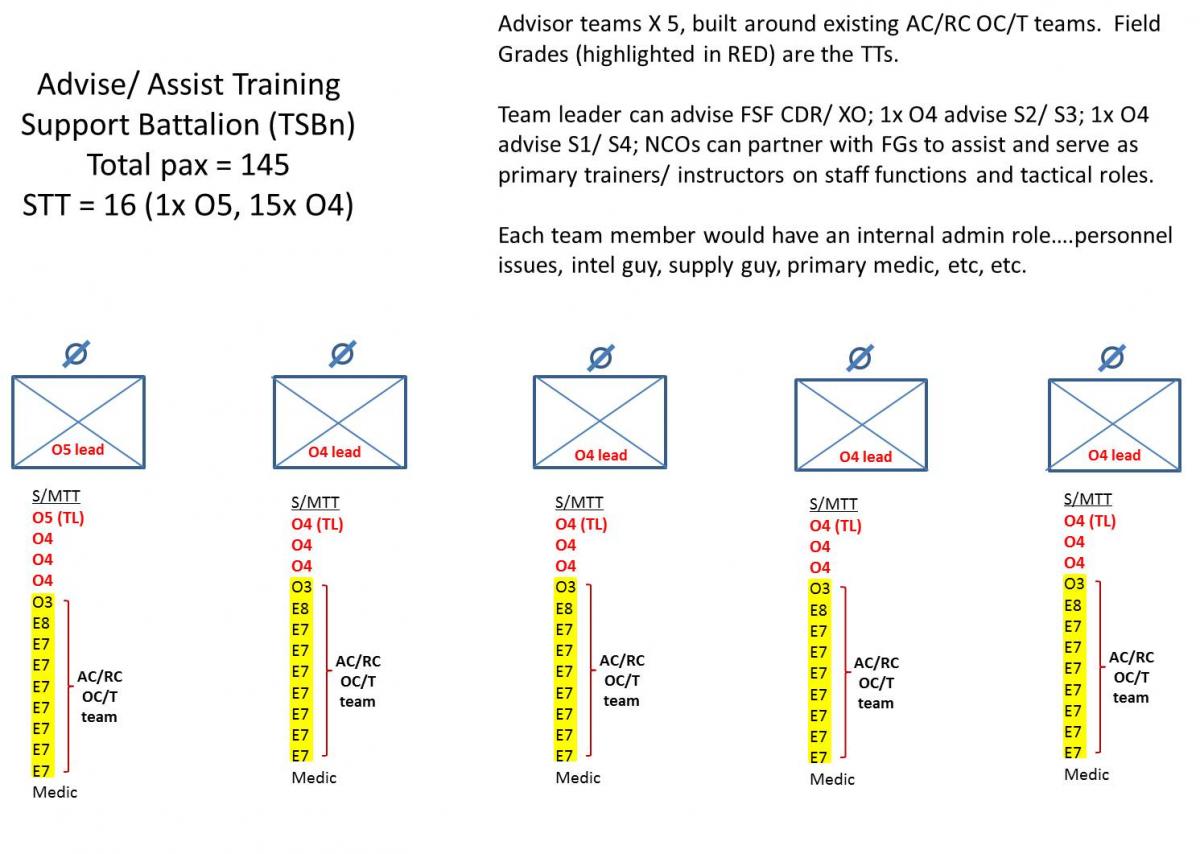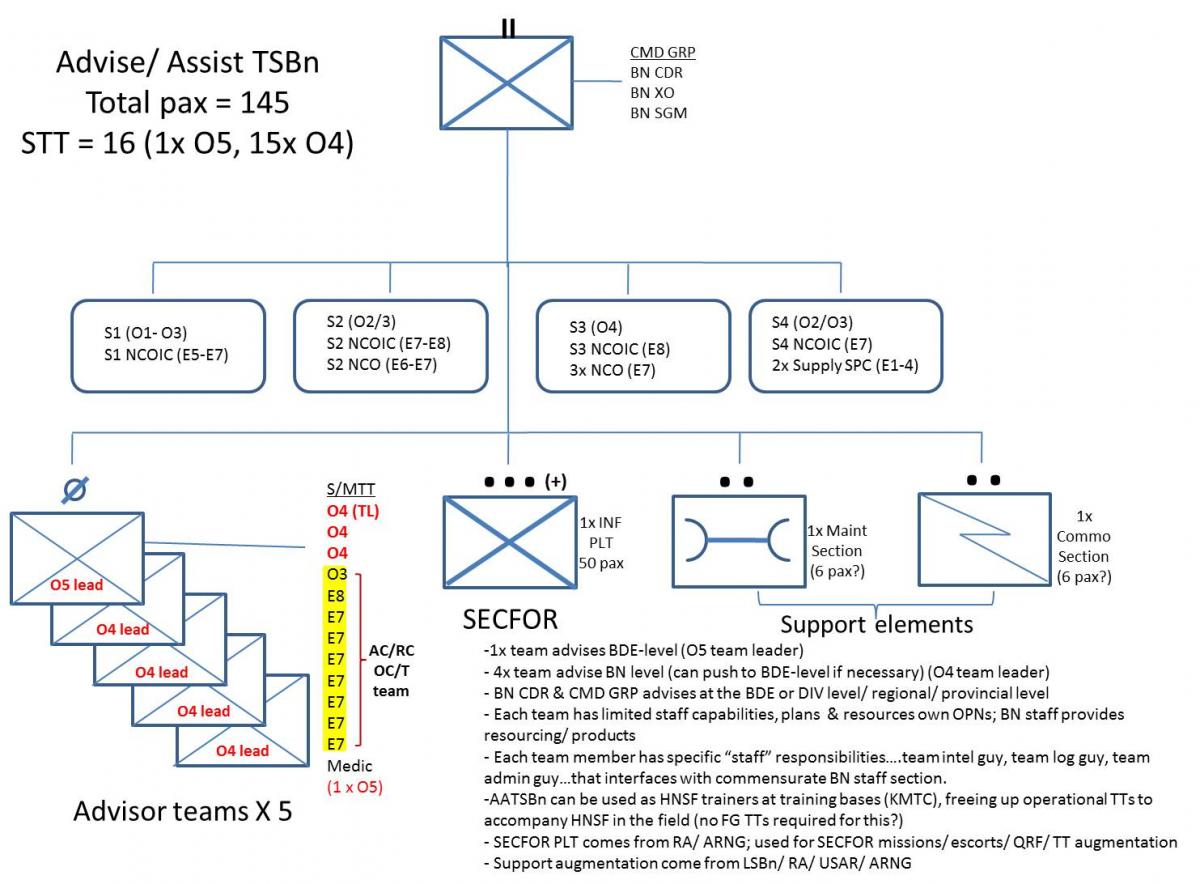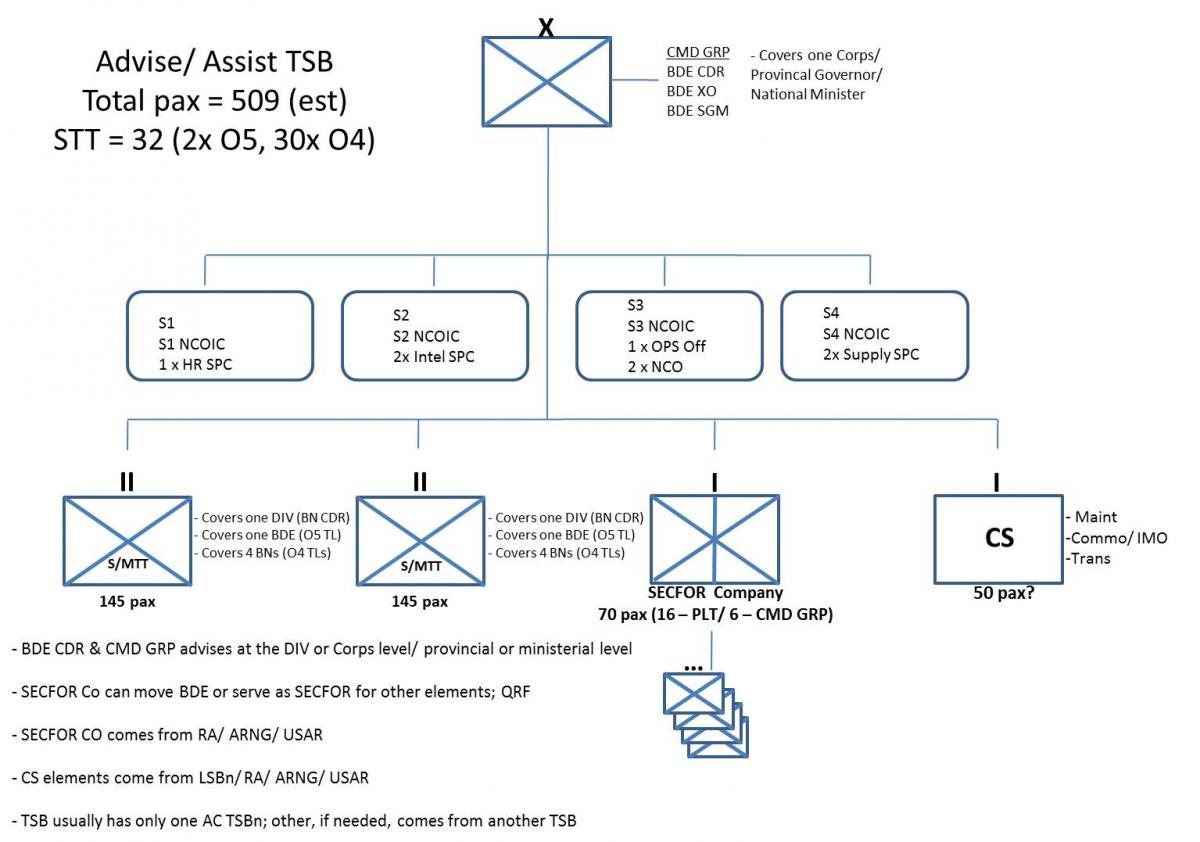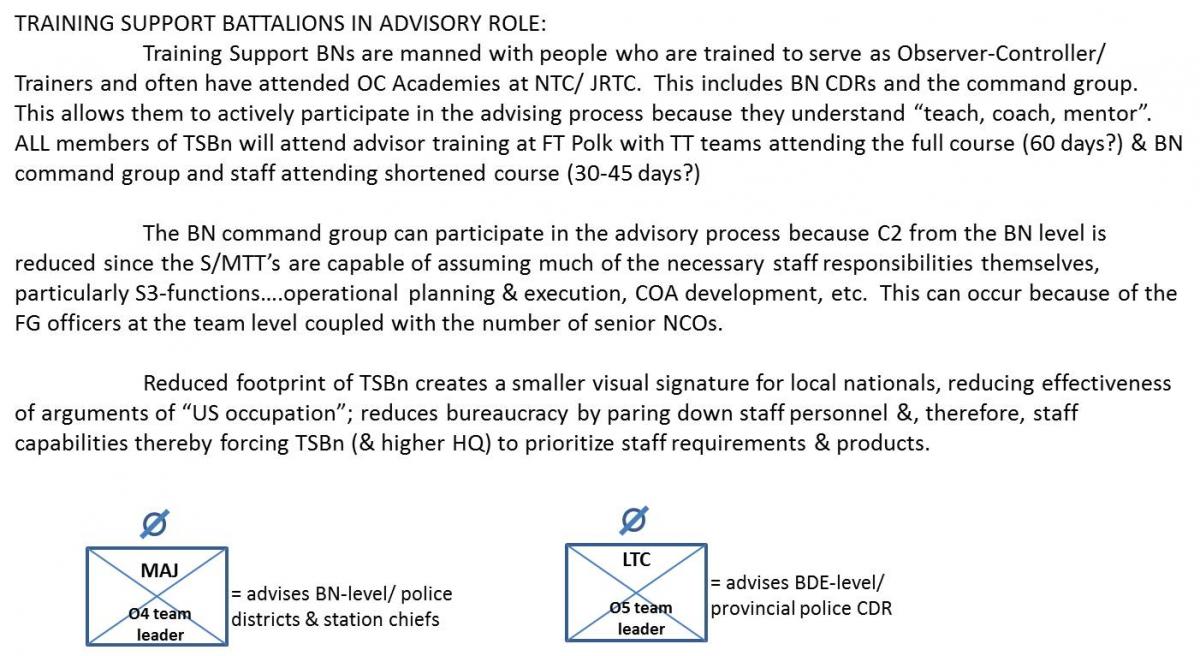We can now dust off those plans to advise and assist that many recommended back in 2009. A recent paper by the Center for a New American Security is advocating a “change of mission” in Afghanistan from the current kinetic counterinsurgency mission, led primarily by US and coalition forces, to an advise and assist mission focused primarily on improving the capabilities of the Afghan National Security Forces (ANSF) through the use of embedded advisor teams. Similarly, in late November, there was a news story about a possible request for some 1700 advisors for Afghanistan as part of the upcoming transition from US-led to Afghan-led combat missions. In both cases, it appears likely that there will shortly be a return to a pre-2009 Task Force Phoenix-like organization in Kabul managing several hundred advisor teams spread throughout Afghanistan.
In the article noted above, the reporter says, “Marine Gen. John R. Allen, who took command in Afghanistan last summer, wants 1,700 more military personnel — mid-level officers and senior enlisted troops leading hundreds of new advisor teams to be assigned beginning next year to Afghan units battling the Taliban insurgency.” Given the problems experienced from 2004 through 2009 in finding enough officers and NCOs to man advisor teams, or Military Transition Teams (MTT), it is likely we will experience similar difficulty this time around should we follow the same manning techniques.
The Advise and Assist Brigade (AAB) concept, where 48 field grade officers are attached to a standard brigade combat team (BCT), was developed to help address the manpower problem of the former MTT concept. But after serving in an AAB as an advisor, I was unimpressed with the preparation, training focus, and subsequent application of the organic elements and personnel of the BCT, which forced many officers and NCOs into the role of advisor with little or no preparation.
If 1700 advisors are what is needed, then I recommend using training support battalions (TSBn) from Active Component/ Reserve Component (AC/RC) brigades augmented with field grade officers as lead advisors.
One of the policy recommendations in the CNAS paper is, “ To the ISAF/U.S. Forces commander: Design and request a post-October 2012 force structure primarily focused on advising and enabling the ANSF to replace U.S. combat units in counterinsurgency operations.”. Using an AC/RC TSBn and its organic observer-controller/ trainer (OC/T) teams as the force structure around which advisor teams are built provides a ready-made element, manned by a senior captain and 8 to 9 senior NCOs, that already understand how to “teach-coach-mentor” which is fundamental to the advisory mission. Adding to each of these OC/T teams two or three field grade (FG) officers who have the rank and clout ANSF leaders expect of their advisors will help reduce the time needed to train the advisory teams because the basic OC/T team has already developed a strong sense of team cohesion and is capable of integrating field grade advisors to become core team members during the pre-deployment training process. Additionally, this will allow us to field teams that have the leadership experience necessary to advise and assist senior ANSF leaders in the collective employment of battalion and brigade-sized units in combat, and reduce the need to pull hundreds of officers and NCOs from across the Army to fill these billets, though many field grades will still have to be sourced from across the force. But since we are already doing this in filling slots for Advise and Assist Brigades (AAB), or Security Force Assistance Brigades (SFAB), expectations for many field grades should remain the same.
The advisory teams I envision would consist of five OC/T teams from an AC/RC TSBn with each team made up of one captain and eight senior NCOs (E7 ad E8). Each team would then be augmented with three FG officers – one to advise the ANSF commander and XO, one to advise the ANSF S2 and S3, one to advise the ANSF S1 and S4 – with the remainder of the team detailed to assist each FG as necessary as well as serve as tactical advisors at the company (or lower) level either in garrison or on operations. Because TSBn’s are manned with people who are trained to serve as OC/Ts and often have attended OC Academies at NTC/ JRTC (may include BN CDRs and the command group), this allows all of them to actively participate in the advising process as well because they understand “teach, coach, mentor”. The battalion command group can participate in the advisory process (at division/ corps/ provincial level) because command and control from the battalion level is reduced since the advisory teams are capable of assuming much of the necessary staff responsibilities themselves, particularly S3-functions….operational planning & execution, COA development, etc. This can occur because of the FG officers at the team level coupled with the number of senior NCOs. Furthermore, the reduced footprint of a TSBn in this role creates a smaller visual signature for local nationals, reducing the effectiveness of arguments about “US occupation”; reduces bureaucracy by paring down staff personnel &, therefore, staff capabilities thereby forcing the training support battalion (& its higher HQ) to prioritize staff requirements & products.
A standard active duty TSBn has approximately 55 to 60 assigned personnel. This includes the five OC/T teams, the command group, and staff sections. Augmenting each OC/T team with three FG requires fifteen FG officers per TSBn to be sourced from across the Army (were this expanded to include the AC/RC Training Support Brigade and two active duty TSBn’s, the FG requirement would be thirty, eighteen less than the current AAB/ SFAB requirement). The TSBn, in preparing for a combat deployment, would have to be augmented with additional personnel to increase the capabilities of, and provide some depth for, their staff sections; provide additional security force elements to assist the advisory teams if necessary and/ or move battalion leaders around the battlefield; and provide for limited maintenance and communications capabilities. These additions can be sourced from Active Duty units, particularly those not slated for anymore brigade-sized deployments, and/or from Reserve Component units who often have plenty of people willing to volunteer for combat deployments.
Predeployment training can be conducted at AC/RC mobilization sites, or the entire battalion can be sent to FT Polk, the current training center for combat advisors. The advisory teams can go through the full advisory training program, which should include a strong language and cultural orientation block, while the command group and staff go through a shortened training program and then deploy ahead of the teams in order to prepare for the arrival and employment of the teams.
Some have argued that using AC/RC OC/Ts in such a manner would go against their primary mission, that of training and mentoring Reserve Component units preparing for operational deployments or mandated training during weekend drills and annual training exercises, leading some training support units to balk at the possibility of giving up experienced OC/Ts for other missions. A valid concern but our reserve forces are now full of combat-experienced Soldiers and leaders. Given the level of experience in many of these units, coupled with the end of operations in Iraq and upcoming reduction in deployments to Afghanistan, it seems that fewer reserve component units will be mobilized, and those that are will require less “teach-coach-mentor” oversight due to their extensive combat experience, which should free up some AC/RC TSBn’s for the advisory missions.
Based on the CNAS report and the news article indicating a possible request for hundreds of advisors organized into advisory teams, formerly known as Military Transition Teams or Embedded Transition Teams (MTT/ ETT), it seems prudent to learn from our previous, haphazard method of manning such teams and make better use of organizations already in our inventory that understand “teach-coach-mentor”. These elements already exist as OC/T teams. By augmenting these teams with field grade officers as the lead advisors, we can deploy cohesive teams with the rank and experience necessary to deal with ANSF leaders, avoid the clumsy manning process used previously, and “create a force structure primarily focused on advising and enabling the ANSF”.

Figure One

Figure Two

Figure Three

About the Author(s)
Comments
I need to preface this reply with the fact the Morgan worked with me on his last assignment in an Advise and Assist Brigade (AAB). That being said, Morgan and I discussed/argued about this many times over the year we were in Iraq. His point is very well taken, and having reflected on the year in Iraq in the recent months, I now have to agree with him on some of his points. Of course as Morgan knows me, I also disagree with him on some of his points.
There have been several articles written on this very topic within the last few years. Colonel (R) Scott Weustner wrote "Building Partner Capacity/Security Force Assistance: A New Structural Paradigm: in 2009. Colonel Gary A. Rosenberg wrote "Security Force Assistance and the Brigade Combat Team: Recommendations for the Way Ahead" in June 2011. A quick Google search and both articles can be found. Both are good articles and do a very good job of presenting recommendations for the way ahead. COL Rosenberg states it best though. The biggest way to make the current construct of Modular Brigade Security Force Assistance (MBSFA) work is a culture change and to adopt certain recommendations of his. One of his recommendations it to create an Additional Skill Identifier (ASI) for people who have done well; I vehemently disagree for many reasons. While I enjoyed my time as an advisor, and saw progress with my Iraqi partners, we would be limiting both Officers and NCOs exposure and understanding of Security Force Assistance (SFA). Also the few with the Combat Advisor ASI would then be put into a do loop of nothing but an advisor mission every couple of years.
The biggest thing that I believe needs to change is the culture of a Brigade with a SFA mission. While we worked with a good unit, there were several Officers on both Brigade (BDE)and Battalion(BN)staff that did not embrace and understand the advisory mission, and that our partners were in the lead. This caused great frustration for many of the advisers. I agree with Morgan that the pre-deployment training with the unit was lacking, what was lacking most, was training for the unit on what MBSFA is and what the role of the advisor was. This is what I believe is the culture change that COL Rosenberg is referring too. The BN and BDE staff received approximately 24 hours of pre-deployment training at home station. This is way too little training for what was then the main effort in Iraq. Also the advisors were often treated as second class citizens. An example is the issuing of our weapons. We did not receive our assigned weapons until less than a month prior to deployment. Our team had a great relationship with the BN we were attached to, and were given NCOs and range time to work with our weapons. Some of our other teams did not. This was very unfortunate, and one of our advisors was finally able to go to a pistol range about 6 months in to the deployment and then found out that his side arm did not function.
There is much more that could and should be discussed about MBSFA as we go forward with this construct. Morgan, great article to create a discourse on this topic, a topic that needs to be discussed at all levels of the Army if this is our road ahead.
LTC Glenn Gambrell
ILE Team 32
Morgan, this is not a new idea. I deployed as an advisor with my AC/RC TSB in 2005-2006 to advise and assist Iraqi Federal Police. I later was the Brigade S3 for an Advise and Assist Brigade in Baghdad 2009-2010. I have to say that I think the Brigade is the right construct. We were lucky to have some fantastic advisors (the 48 Augmentee FGs) and Brigade/Battalion command teams that understood the premise "The ISF is our battle space". It doesn't hurt to emphasise to a commander that his evaluation is based in large part on how his Host Nation Partner develops over time.
I disagree that advisors should be given KD credit as the advisor role and the more traditional KD jobs are quite different and not comparable. By keeping to a Brigade construct, you eliminate the need to incentivize the advisory role. Arguably, an officer that is selected for BN or BDE Command has already proven very successful and therefore, the "right guys" are being selected to advise and assist. We get hung up on the difference between advising and partnering; with one singular construct and one single chain of command, the differences become less significant. Thanks for what you do and for sharing your experiences.
Marc
I believe what may be the best and easiest answer here is to request former MiTT members to volunteer for duty and fill this role.
What must happen, however, is that for this duty must suffice for key developmental time for those involved. Otherwise it's really screwing those on a team.
Create 19-person teams, having two interpreters and two females, leaving 15 standard troops in the old MiTT scheme (though many teams did not have that many people). Once in country each team can hire several local interpreters, making the formation around 23 pax or so. If they roll in 5x vehicle formations they should have adequate fire power, CASEVAC platform, etc. And go austere, mobility is the key, not comfort.
Send these groups to Bragg for 90 days of "MATA" training from experienced SF guys and establish and advisory cell, much like Asymmetric Warfare Group to move through theater and assist teams, as well as provide advice from a HQ location.
Ensure group cohesion while at Bragg so that teams don't deploy in an already broken state. Then tell them they are headed out for the duration. When OEF is done, they come home, but not until then. Larger teams allow some redundancy in partnership with counterparts, more force protection, greater mobility, and allow more liberal mid-tour leave possibilities, not to mention the additional cross training that can take place. Model like a plussed up ODA with some common sense changes and I think you have a good capability.
This advising thing can work but it must be fully committed to, not just half way as we did with the MiTTs.
I agree with the statement that they are good at unconventional unit force multipliers, but again, speaking from my experiences, none of the Teams were interested in HN forces, except as extra firepower for them. The Advisors need to be as good, if I dare say better than SF. When I was an advisor, we operated "down range" in two man teams. We had no support, but still needed to be our own weapons experts, medics, JFO, engineers, etc. SF may be good for the initial entry stages of training local guerillas, but a perm. advisor team should be available for entry once a new government/army is formed to Organize, Train, Equip and Advise the new army.
Chester,
I wouldn't go so far as to say that the SF bubbas have been unsuccessful over the last decade. I suspect that they've been spread so thin that their impact has been less that it could've been, at least until the introduction of village stability teams (the Gant Plan)
As for the advisor teams I am recommending, a CPT I worked with previously summed it up rather well when he explained that SF trains unconventional forces and MTTs (or the teams I am advocating) train conventional forces.
I agree and have argued this concept of perm. Advisor Teams for years. Now I am at a level in the Army where I can argue it to decision makers. Unfortunately, many want to give this back to the SF community, who have not been too sucessful at this for the last decade. However, having been an advisor in Afghanistan in '04, and the current trends and operations taking place, the time is NOW for well trained and perm. teams. The adhoc concept of the last 10-years has been a bandaid on a major wound.
This is an excellent and original idea that strikes me as having next to no chance of being implemented. The Army has tied its cart to the AAB/MB-SFA horse, for better or for worse.
The GAO report "<a href="http://www.gao.gov/products/GAO-11-760">Actions Needed to Enhance the Ability of Army Brigades to Support the Advising Mission</a>," published in August, goes into a number of problems with the concept, but there are an equally significant list of issues with the MTT format (mostly related to command and control/coordination with battlespace owners, etc.).
Original thinking on this subject is in extraordinarily short supply, and this strikes me as a workable concept. But the Army has spent at least three years (and an FM) on the brigade-centric model, and I don't see them giving up on it easily. It's infuriating to see all this talk about a shift in emphasis from COIN to SFA, etc., considering that <em>these units have been in Afghanistan for years</em> and should've facilitated that transition by now, but it is what it is, I guess.
